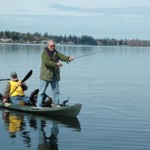
Harperites reluctantly transfer Experimental Lakes Area to Winnipeg think tank.
by Stephen Leahy
After a solid year of Canadian public, researchers, and international science community outrage, the Harper government finally yielded and agreed to transfer the world-renowned Experimental Lakes Area (ELA) to a non-profit organization. And then — and then! — the Minister of Fisheries and Oceans tried to take credit for the May 10 announced signing of a crucial Memorandum of Understanding with the Winnipeg-based International Institute for Sustainable Development (IISD).
“The Harper government was being hammered on this from every conceivable angle before they finally buckled,” said Diane Orihel, PhD student at University of Alberta and founder of the Coalition to Save ELA.
Although the ELA cost the federal government just $2 million a year to operate, it was shuttered March 31st. By comparison, Canadians paid $1 million to ship Stephen Harper's armoured limo and SUV to India for a state visit last November.
The ELA is a 45-year-old freshwater research facility in northern Ontario considered unique in the world. It was there that Canadian scientists discovered the dangers of acid rain as well as mercury and phosphorus pollution. Regulations that protect the health of the environment in Canada and many countries are based on the work done at the ELA.
Claiming a need for austerity, the Harper government slashed the budgets of Fisheries and Oceans and Environment Canada last year. The ELA cost the federal government just $2 million a year to operate but it was shuttered March 31st.
For comparison, it cost Canadians $1 million to ship Stephen Harper's armoured limo and SUV to India for a state visit last November.
“This transfer is only happening because independent scientists asked the IISD to try and convince the government to make it happen,” Orihel told DeSmog.
Only a few days ago scientists called on the Harper government to allow access to the ELA to continue the world’s longest, whole-lake eutrophication experiment. That experiment is fully funded and crucial to understanding the causes of economically devastating algal blooms in freshwater lakes such as Lake Erie, she said.
The transfer is not a done deal, however. Many issues remain outstanding.
“It’s a big step forward. The ELA does critically important science for Canada and the rest of the world,” said Scott Vaughan, CEO and president of IISD, an internationally respected public policy research institute.
“Saving the ELA is the right thing to do,” Vaughan said.
The best part of the May 10 MOU is an agreement to allow scientists back into the ELA to continue their research for the balance of the year. Present and future liability, staffing, remediation responsibilities and other legal matters still need to be negotiated. However Fisheries and Oceans are working to address a number of issues with the intent of turning over the ELA to IISD in good shape, he said.
Finding $2 million to run the ELA is “a big challenge” for the non-profit IISD that has to fundraise for its core operations. “We didn't take this on lightly,” he acknowledged.
In order to offer informed policy advice on sustainable development, the IISD needs sound scientific data on freshwater and climate change such as that provided by researchers at the ELA, he said.
While Orihel is happy she'll be back at the ELA continuing her research this year, she is disappointed no new research programs will be permitted. One of those ready to go was designed to investigate the environmental impacts of nanosilver particles found in products like food containers, socks, shoe inserts, sports clothing and towels. Nanosilver particles are smaller than a virus and lab research has shown they can mutate fish embryos.
It says a lot about what is happening in Canada that in order to save an invaluable scientific resource it has to be taken out of the hands of government, she said.
“A year ago I would never believed I would say I'm delighted the ELA will soon be freed from the shackles of our federal government.”
© Copyright 2013 Stephen Leahy, All rights Reserved. Written For: StraightGoods.ca
 Stephen Leahy is an environmental journalist based in Uxbridge, Ontario.
Stephen Leahy is an environmental journalist based in Uxbridge, Ontario.
Sorry, the comment form is closed at this time.